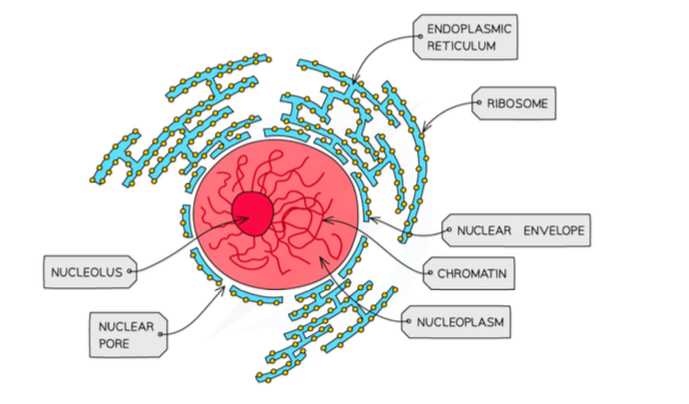Cell structure
1/23
There's no tags or description
Looks like no tags are added yet.
Name | Mastery | Learn | Test | Matching | Spaced |
|---|
No study sessions yet.
24 Terms
Eukaryotic vs prokaryotic cell
Eukaryotic cells contain membrane-bound organelles; prokaryotic cells do not
What are organelles
Structures found inside a cell
Nucleus size usually
5-10 μm
Draw a nucleus

What kind of cells is the nucleus in
All eukaryotic cells except red blood cells
What separates the nucleus from the cytoplasm
Nuclear envelope (double membrane)
Why does the nuclear envelope have pores
Allow mRNA and ribosomes out; allow enzymes in
What is chromatin
Material which chromosomes are made from; found in the nucleus
What is the nucleolus
Structure inside the nucleus where ribosomes are produced
What surrounds the nucleus
Rough endoplasmic reticulum + ribosomes
Size of mitochondria usually
0.5-1μm
Name features of the nucleus
Nucleolus, chromatin, nucleoplasm, nuclear envelope, nuclear pores
Function of a mitochondrion
Site of aerobic respiration in all eukaryotic cells
Describe structure of mitochondria
Surrounded by double membrane; inner membrane folds to form cristae
What are cristae
Structures formed by the inner membrane of a mitochondrion
What is the matrix
Inside cristae of mitochondria; contains enzymes needed for aerobic respiration
Where are mitochondria found
Eukaryotic cells; self replicating so abundant in cells where much metabolic activity takes place to provide energy
Chloroplast size usually
2-10μm
Where are chloroplasts found
Plant cells which photosynthesise
Chloroplast structure
Double membrane, then thylakoid membranes form grana joined together by lamellae
What are thylakoids
Membrane bound structures in chloroplasts containing chlorophyll; site of photosynthesis
What else do chloroplasts contain other then thylakoids
Small circular pieces of DNA, ribosomes, stroma (like cytoplasm)
Ribosome structure
No membrane
Where are ribosomes normally found in cells
Cytoplasm/RER